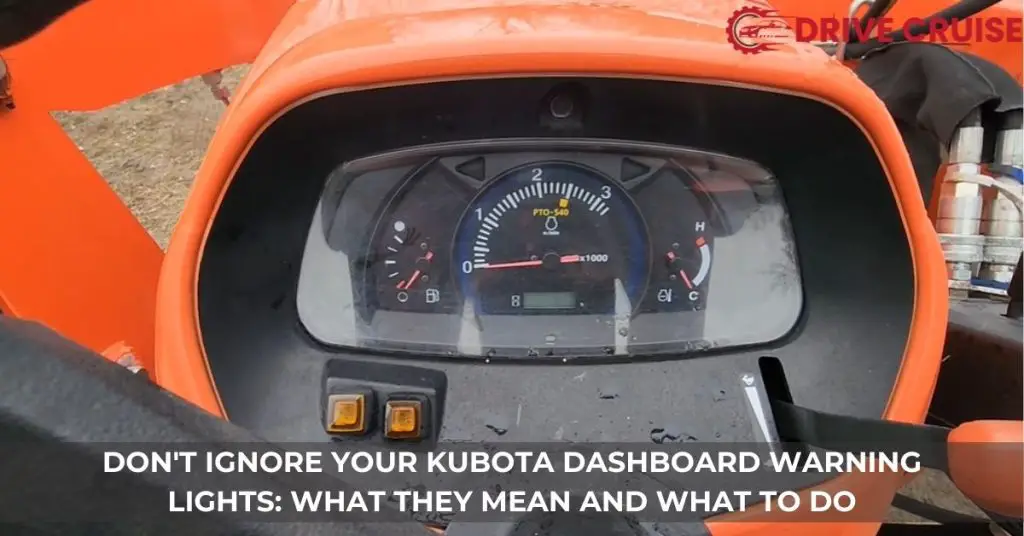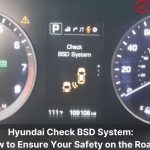Navigating the dashboard of your Kubota tractor can sometimes feel like deciphering an ancient script. Those little illuminated symbols aren’t just for show; they’re a crucial line of communication between you and your machine. Understanding what they mean can be the difference between a minor fix and a major repair down the line.
We’ve all been there, glancing down at the dashboard only to find a warning light staring back at us. It’s easy to feel a twinge of panic. But fear not! We’re here to guide you through the maze of Kubota dashboard warning lights. With a bit of knowledge, you’ll be interpreting those cryptic symbols like a pro, ensuring your tractor remains in tip-top shape for years to come.
Understanding Kubota Dashboard Warning Lights
In our guide, we dive into the specifics of what each Kubota dashboard warning light signifies and how to address them. Recognizing these signals early can save time, money, and prevent potential harm to your tractor.
Oil Pressure Warning Light
This light resembles an oil can and illuminates when the oil pressure in the engine drops below a safe level. If you see this, stop the tractor immediately to avoid engine damage, and check the oil level after the engine has cooled down.
Temperature Warning Light
Signified by a thermometer, this light warns when the engine’s temperature exceeds the normal range. Overheating can lead to significant engine problems. Should this light come on, turn off the engine, and allow it to cool before checking coolant levels.
Battery Charge Warning Light
A battery symbol on the dashboard indicates issues with the tractor’s charging system. A persistent light might mean a failing alternator or battery. It’s crucial to inspect the battery connections and consider testing the battery and alternator.
Engine Preheat Indicator
Represented by a coiled wire, this light comes on during the engine’s preheat cycle before starting in cold conditions. It’s normal for this light to turn off once the engine is ready for ignition.
Hydraulic Oil Pressure Warning
A warning light showing a hydraulic filter indicates a problem with hydraulic fluid pressure. Low pressure can affect the tractor’s operation and requires immediate checking of the hydraulic fluid levels and filters.
Understanding these warning lights and responding appropriately ensures your Kubota tractor remains in optimal working condition. Regular maintenance checks can prevent many of these issues before they occur, keeping your Kubota reliable for years to come.
Common Kubota Dashboard Warning Lights and Their Meanings
In our journey to help Kubota tractor owners maintain their machinery in top-notch condition, understanding the common dashboard warning lights is crucial. Here, we decode some of these lights and their meanings, aiming to empower you with the knowledge needed for timely interventions.
- Oil Pressure Warning: This light resembles an oil can. If it illuminates while operating your Kubota tractor, it indicates low oil pressure within the engine. Ignoring this light may lead to engine damage due to inadequate lubrication. Checking the oil level and pressure is the first step if this light comes on.
- Temperature Warning: Displayed as a thermometer dipping into water, this light warns of the engine overheating. Overheating can cause significant damage to your tractor’s engine. It’s essential to stop the tractor and allow the engine to cool down before checking coolant levels and the radiator for blockages.
- Battery Charge Warning: Represented by a battery symbol, this light signals an issue with the tractor’s charging system. If this light stays on while the engine is running, it may indicate a failing battery or alternator. Ensuring your tractor’s battery charges correctly is vital for its electrical system and overall performance.
- Engine Preheat Indicator: This light, looking like a coil or spring, illuminates when the engine preheat system is in operation. It’s a normal indicator light that goes off once the engine is sufficiently warmed up and ready for starting. This light is particularly prevalent in colder environments.
- Hydraulic Oil Pressure Light: A warning light showing a drop of liquid with an arrow indicates low hydraulic oil pressure. Hydraulic systems are pivotal for various tractor functions. Maintaining optimal hydraulic oil levels ensures the smooth operation of these systems.
Recognizing and responding to these dashboard lights promptly can prevent minor issues from escalating into major problems. By familiarizing yourself with these warning indicators, you’re taking a significant step toward prolonging your Kubota tractor’s lifespan and maintaining its efficiency.
Troubleshooting Tips for Kubota Warning Lights
In building upon our understanding of Kubota dashboard warning lights, we aim to guide you through troubleshooting these crucial indicators. Addressing these lights promptly can avert potential damage, ensuring your tractor’s longevity and optimal performance.
Check the Operator Manual: First, refer to your Kubota tractor’s operator manual. This resource contains detailed information on each warning light and the recommended actions to take.
Oil Pressure Light: If the low oil pressure light activates, stop the engine immediately. Check the oil level and refill if necessary. If the light remains on after refilling, it suggests a deeper issue necessitating a professional checkup.
Temperature Warning Light: An illuminated temperature warning light indicates the engine is overheating. Allow the engine to cool down before checking coolant levels, and replenish if levels are low. Inspect for leaks as these could signify more significant issues.
Battery Charge Warning Light: Should the battery charge light come on, inspect the battery terminals for corrosion and ensure they’re tight and clean. A persistently lit battery charge light might indicate a failing alternator, requiring professional attention.
Engine Preheat Light: A blinking engine preheat light during colder months is common. If it stays on longer than usual, check for damaged preheat plugs or a failing electrical connection.
Hydraulic Oil Pressure Light: When the hydraulic oil pressure light is on, verify the hydraulic oil level and replenish if needed. Persistent illumination can signal a leak or pump damage, which needs an expert’s diagnosis.
By recognizing these signals and performing preliminary checks, you can address minor issues before they escalate. However, if a warning light persists after basic troubleshooting, it’s vital to consult with a Kubota technician. Regular maintenance and timely response to dashboard warning lights play a pivotal role in preserving your tractor’s functionality and efficiency.
Maintenance Tips to Avoid Triggering Warning Lights
Maintaining a Kubota tractor in top condition involves more than just addressing dashboard warning lights when they illuminate. Proactive maintenance can significantly reduce the risk of warnings. Here, we’ll share effective maintenance tips that keep those warning lights off and ensure the tractor operates efficiently.
Regularly Check Fluid Levels
- Engine Oil: Checking the oil level regularly ensures the engine runs smoothly. A drop below the recommended level could trigger the oil pressure warning light.
- Coolant: The right coolant level is crucial to prevent overheating. Low coolant triggers the temperature warning light.
- Hydraulic Oil: Hydraulic system efficiency depends on adequate oil levels. Insufficient hydraulic oil activates the hydraulic oil pressure light.
Battery Maintenance
- Terminals: Keeping battery terminals clean and corrosion-free ensures a good electrical connection, preventing the battery charge warning light from coming on.
- Charge Levels: Regularly check the battery charge, especially before heavy use, to avoid unexpected battery discharge indicators.
Filter Inspection and Replacement
- Air and Fuel Filters: Dirty air and fuel filters can strain the engine and hydraulic systems, leading to increased fuel consumption and reduced efficiency. Regular inspections and replacements help avoid these issues.
- Professional Inspections: Kubota tractors benefit from professional servicing to check for potential issues that aren’t obvious during regular operation. This includes inspecting the engine, hydraulic system, and electrical systems.
- Operator’s Manual: Following the service schedule outlined in the operator’s manual ensures all critical components receive attention before problems develop.
Implementing these maintenance tips helps prevent common issues that trigger dashboard warning lights. Ensuring fluid levels are correct, maintaining the battery, inspecting filters, and adhering to scheduled service checks keep a Kubota tractor performing at its best, reducing the likelihood of unexpected downtime and maintaining efficiency and performance.
Conclusion
We’ve walked through the essential steps to not only understand but also address the Kubota dashboard warning lights. Remember, these indicators are your tractor’s way of communicating its health and needs. By following our troubleshooting tips and embracing proactive maintenance, we can prevent most issues before they escalate. Let’s keep our Kubota tractors in top shape by staying informed and taking timely action. Here’s to fewer warning lights and more productive days in the field!
Related Posts:
- Decoding Kioti Tractor Warning Lights: A Friendly Guide
- Don’t Ignore Your Kubota Dashboard Warning Lights: What They Mean and What to Do
- Stay Safe with Kubota Skid Steer Warning Lights: Essential Guide
- Kubota SVL75-2 Warning Lights: What You Need to Know
- Decoding Bobcat Warning Light Symbols: A Friendly Guide to Their Meaning
- Stay Safe on the Job with Case Skid Steer Warning Lights
- Decoding John Deere Tractor Warning Lights: What Do They Mean?
- Decoding Kenworth Dash Warning Lights: Understanding Their Meanings
- Nissan Dashboard Key Symbol: What Does It Mean?













